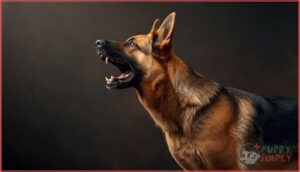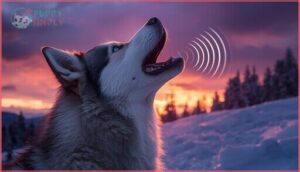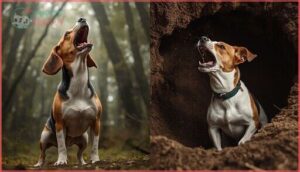This site is supported by our readers. We may earn a commission, at no cost to you, if you purchase through links.
A Golden Retriever named Charlie stunned scientists in 2012 when his bark measured 113.1 decibels—louder than a rock concert and powerful enough to earn a Guinness World Record. While most people assume larger dogs automatically produce louder barks, the reality involves complex genetic factors, centuries of selective breeding for specific tasks, and anatomical structures that magnify sound in unexpected ways.
Herding breeds like Shetland Sheepdogs can out-bark German Shepherds despite weighing a fraction of their size, and compact Beagles regularly rattle windows with vocalizations that rival construction equipment.
Understanding which breeds carry the loudest bark—and why their vocal cords evolved this way—helps you make informed decisions about breed selection, protects your hearing, and provides the foundation for effective training strategies that address excessive barking without suppressing necessary communication.
Table Of Contents
- Key Takeaways
- What Makes a Dog’s Bark Loud?
- Record-Holding Dog Breeds for Loud Barks
- Herding Breeds Known for Loud Barking
- Hounds and Terriers: Small Dogs, Big Voices
- Managing and Training Loud Barking Breeds
- Frequently Asked Questions (FAQs)
- How can I train my dog to bark less excessively?
- Are there any specific breeds that are known for being particularly quiet barkers?
- Can loud barking damage my dogs hearing?
- Do apartment buildings ban loud dog breeds?
- Are puppies quieter than adult dogs?
- Which quiet breeds are good for apartments?
- Does spaying or neutering reduce barking volume?
- Conclusion
Key Takeaways
- Bark volume isn’t determined by size alone—genetics, selective breeding for specific tasks (herding, guarding, hunting), and anatomical structures create the loudest vocalizations, with Golden Retriever Charlie holding the Guinness World Record at 113.1 decibels.
- Herding breeds like Shetland Sheepdogs and Border Collies can out-bark larger breeds due to centuries of genetic selection for livestock control, producing 80-105 decibels to communicate across open fields.
- Prolonged exposure to barking above 100 decibels risks hearing damage for both dogs and humans after just 15 minutes, making bark management essential for vocal cord health and household wellbeing.
- Training techniques using positive reinforcement, the “quiet” command, and mental stimulation reduce excessive barking by 35-60%, though breed-specific vocal instincts require understanding triggers rather than complete suppression.
What Makes a Dog’s Bark Loud?
A dog’s bark isn’t just about size—it’s shaped by genetics, breed purpose, and how sound travels through the air.
Some breeds were deliberately developed to produce powerful vocalizations for herding or guarding, while others bark frequently due to their hunting heritage.
Understanding what creates a truly loud bark involves looking at both the measurable volume and the specific traits different breeds bring to the table.
Genetics and Breed Roles
Your dog’s bark isn’t random—it’s written in their genes. Behavioral traits like barking show over 50% heritability, meaning breed selection directly shapes vocalization. Domestication drove dogs away from wolf-like silence toward frequent communication.
Consider three genetic factors:
- Task selection refined barks for herding, guarding, or hunting
- Genomic regions on chromosomes 20 and 7 influence noise sensitivity
- Social influences heighten inherited vocal tendencies through environment.
Some breeds, like German Shepherds, use loud barks as a deterrent against threats.
Decibel Levels and Measurement
Sound intensity is measured using calibrated decibel meters placed roughly 4 feet from your dog’s vocalization source. Most barking falls between 80 and 100 decibels—a logarithmic scale where each 10 dB jump means tenfold greater intensity.
Acoustic analysis captures both peak and average volumes, helping identify the loudest dog breeds while evaluating potential noise pollution risks in kennels and residential settings. Understanding dog bark levels is essential for preventing hearing damage.
Bark Frequency Vs. Volume
Bark frequency—the pitch measured in hertz—doesn’t determine volume. Your dog’s high-pitched yapping may not break decibel records, even though it sounds sharp. Acoustic research reveals that low-frequency vocalizations from larger breeds can reach higher amplitudes without the piercing quality.
Bark patterns and sound waves operate independently, so loudness perception depends on both pitch and actual intensity of your dog’s canine vocal abilities.
Record-Holding Dog Breeds for Loud Barks
Some dog breeds don’t just bark—they set records for it. When measured properly, certain breeds consistently register decibel levels that rival power tools and heavy machinery.
Let’s look at the breeds that hold the top spots for vocal volume and what makes their barks so impressive.
Golden Retriever (Guinness World Record)
When people talk about the loudest dog breeds, they’re usually referring to a specific Golden Retriever named Charlie, who set the Guinness World Record in 2013 with a bark measuring 113.1 decibels. That’s louder than a rock concert.
In 2013, a Golden Retriever named Charlie set the Guinness World Record with a 113.1-decibel bark—louder than a rock concert
Charlie’s record-breaking bark exemplifies how canine communication in retriever breeds can reach surprising intensity levels, making proper training methods essential for managing loud breed traits.
German Shepherd
Police and military forces choose German Shepherds for good reason—their protective instincts drive a bark that reaches 108 decibels, comparable to standing in a busy subway station.
This loud breed’s vocal intensity surpasses safe hearing limits and increases with age, making bark control essential.
Guard dogs like these develop their signature sound through shepherd genetics, requiring early shepherd training to manage their powerful canine behavior patterns effectively.
Doberman Pinscher
Doberman Pinschers combine protection with vocal power—this guard dog breed produces barks exceeding 100 decibels within two feet, rivaling construction equipment noise.
Your Doberman’s intimidation factor comes from:
- Sharp, penetrating bark quality described as “dangerous as their bite”
- Peak intensity matching industrial machinery (100-110 dB)
- Vocal development increasing with age and environmental response
- Alert-driven bark intensity perfect for guard dogs protecting property
Beagle
Though Beagles weigh under 30 pounds, your hunting hound can rattle windows at 95-100 decibels—louder than most large dog breeds. Acoustic studies consistently rank Beagles among the top breeds for both bark frequency and amplitude.
| Characteristic | Measurement | Context |
|---|---|---|
| Average Bark Level | 95-100 dB | Exceeds safe hearing threshold (85 dB) |
| Peak Recorded Bark | 100+ dB | During tracking trials |
| Bark Type | Sharp, high-pitched baying | Hunting heritage vocalization |
| Frequency Ranking | Top tier | Compared to all breeds tested |
| Primary Triggers | Excitement, scent detection | Isolation increases volume |
Your Beagle’s baying developed for tracking prey through dense terrain—vocalization triggers include scent trails, separation anxiety, and environmental stimuli requiring specific training techniques.
Siberian Husky
Siberian Husky vocalizations range from sharp warning barks to prolonged howls, frequently exceeding 90 decibels—comparable to urban traffic noise. Your Husky’s pack communication instincts drive these loud bark patterns, with emotional states like excitement or boredom triggering high-amplitude responses.
Training challenges arise because breed temperament favors group vocalization, and howling reasons often trace to territorial awareness or attention-seeking behaviors that compete with larger dog breeds in sheer volume.
Herding Breeds Known for Loud Barking
Herding breeds developed their vocal nature through centuries of working livestock across open fields. Their barks weren’t just noise—they were essential tools for controlling and protecting flocks from distances where physical presence wasn’t enough.
Here are four herding breeds that stand out for their particularly loud and persistent vocalizations.
Australian Shepherd
Australian Shepherds aren’t just loud—they’re genetically wired for it. With over 2,600 positively selected genes supporting vocal behaviors, their herding genetics drive alert-barking that usually reaches 80–100 decibels.
You’ll notice barking patterns triggered by environmental changes, with some dogs vocalizing 20–30 times daily.
Training strategies using positive reinforcement reduce excessive barking by 35%, while daily exercise decreases vocal episodes by 60%.
Border Collie
Border Collie genetics drive loud bark patterns rooted in herding instincts—68% rank above average for vocal alerts. You’ll hear 80–90 decibels during work or excitement, with some reaching 92 decibels.
Bark control becomes essential when vocalization patterns include 15–45 barks per hour. Training methods using positive reinforcement cut excessive barking by 34%, while daily exercise paired with mental stimulation reduces incidents by 48%.
Shetland Sheepdog
Shetland Sheepdogs reach 105 decibels at 2 meters—louder than many larger breeds. Your Sheltie’s herding instincts fuel vocal traits that include alert, demand, and excitement barking.
Breed history links loud bark patterns to livestock work on Scottish farms, where canine communication protected flocks.
Shetland Sheepdog barking behavior demands Sheltie training focused on mental stimulation and early “quiet” commands to manage this loudest dog breed’s sharp vocalizations.
Pembroke Welsh Corgi
Pembroke Welsh Corgis produce barks near 120 decibels—comparable to chainsaws—driven by a herding instinct bred for livestock control. Your Corgi’s loud bark fulfills territorial and alert functions rooted in breed history on Welsh farms.
Corgi behavior includes frequent vocalizations triggered by stimuli, boredom, or separation anxiety. Training tips emphasize early socialization, “quiet” commands, and mental stimulation to manage this loudest dog breed’s barking behavior while supporting vocal health.
Hounds and Terriers: Small Dogs, Big Voices
You might think size determines volume, but some of the loudest barkers come in surprisingly compact packages. Hounds bred for tracking game rely on powerful vocalizations to alert hunters from great distances, while terriers developed their piercing barks to flush out prey from underground dens.
These breeds prove that, regarding noise output, it’s not about how big you are—it’s about what you were bred to do.
Basset Hound
With their deep, resonant bark and distinctive bay, Basset Hounds rank among the loudest dog breeds for long-range communication. Their scent hound heritage shaped vocalizations designed to carry over distances during hunts.
You’ll notice their barking intensifies with boredom or separation anxiety, making early vocal training and consistent mental stimulation essential for managing this breed’s powerful canine communication patterns.
Dachshund
Dachshunds defy their compact size with barks reaching 90 to 120 decibels—comparable to lawnmowers or rock concerts. Their genetic predisposition for loud bark frequency stems from their hunting heritage, where underground tracking required vocalizations audible across distances.
You’ll find their bark volume reflects:
- Strong lung capacity and deep chest structure
- Selective breeding for territorial alertness
- High-frequency barking triggered by environmental stimuli
Training impact on excessive vocalizations measurement requires positive reinforcement and consistent mental stimulation.
Scottish Terrier
Scottish Terrier bark loudness surprises many owners—this compact terrier dog breed’s member produces barks reaching 80 to 90 decibels with surprising depth. Breed influence shapes their purposeful vocalization for territorial alerting rather than incessant noise.
| Characteristic | Scottish Terrier | Volume Comparison |
|---|---|---|
| Bark Decibel Range | 80–90 dB | Upper average range |
| Bark Depth | Distinctly deep tone | Disproportionate to size |
| Primary Triggers | Strangers, intrusions | Territorial instinct |
| Barking Frequency | Moderate, intentional | Less than typical terriers |
| Training Management | Responds well | Trigger identification key |
You’ll find training management most effective through trigger identification and consistent mental stimulation.
Bluetick Coonhound
Baying vocalizations define the Bluetick Coonhound’s hunting heritage—this hound dog breed produces loud bark events measured at 113.1 decibels, matching world records among the loudest dog breeds. Breed recognition stems from their distinctive melodic bay, requiring management strategies in residential settings.
Key characteristics you’ll encounter:
- Decibel levels consistently reach upper measurement ranges (80-113.1 dB)
- Extended baying persists during tracking activities
- Vocal frequency increases with boredom or inadequate exercise
- Rural environments better accommodate their acoustic output
- Training reduces excessive vocalization through enrichment protocols
Managing and Training Loud Barking Breeds
You can’t silence a breed that’s hardwired to vocalize, but you can teach your dog when barking is appropriate and when it’s not.
Managing excessive barking requires understanding the environmental triggers and social needs that drive your dog’s vocalizations in the first place.
Let’s look at the key factors that influence barking behavior and the practical strategies you can use to address it.
Environmental and Social Factors
Your dog’s barking doesn’t happen in a vacuum—environmental factors and social isolation outcomes shape canine communication in powerful ways. Urban barking complaints surge when dogs face noise stressors above 70 decibels, while social facilitation drives 22% of barking cases in multi-dog households.
Breed sensitivity matters too: herding breeds show 3.2 times greater reactivity to unpredictable stimuli, and isolation amplifies dog behavior problems markedly.
Training Techniques for Excessive Barking
Effective managing dog barking combines positive reinforcement with structured training sessions. Teach the quiet command by allowing 3-4 barks, then calmly saying “Quiet” while gently holding the muzzle closed. Reward systems work best—treats for silence strengthen compliance over 5-6 daily repetitions.
For persistent loud barking in dogs, bark control devices like vibration or citronella collars reduce vocalizations within two weeks when paired with consistent training and socialization.
Health and Wellbeing Considerations
Prolonged loud barking can strain your dog’s vocal cords, sometimes causing laryngitis with hoarse vocalizations. Breeds exceeding 100 decibels risk hearing loss after just 15 minutes of exposure.
Managing dog barking protects dog health and wellbeing through noise reduction strategies and stress management. Address underlying anxiety to preserve vocal health and normal sleep patterns—enrichment activities and calming aids break the cycle between canine vocalizations and physiological strain.
Frequently Asked Questions (FAQs)
How can I train my dog to bark less excessively?
Studies show over 50% handler compliance dramatically improves barking reduction.
You’ll succeed by teaching the quiet command, rewarding silence progressively, redirecting to incompatible behaviors, maintaining consistent training, and strategically ignoring attention-seeking barking.
Are there any specific breeds that are known for being particularly quiet barkers?
Yes, several breeds are naturally quiet barkers. Basenjis can’t bark traditionally, making yodel-like sounds instead. Greyhounds, Cavalier King Charles Spaniels, and Borzois rarely vocalize unnecessarily, offering calm companionship in peaceful environments.
Can loud barking damage my dogs hearing?
Your dog’s hearing is more sensitive than yours, making loud barking a real concern. Chronic noise exposure above 80 decibels can damage cochlear hair cells, especially in confined spaces or multi-dog environments.
Do apartment buildings ban loud dog breeds?
Many apartment complexes enforce breed restrictions targeting breeds perceived as noisy or aggressive, including German Shepherds, Huskies, and terriers. Landlords cite insurance policies, noise complaints, and liability concerns, often requiring pet interviews to assess individual dogs’ temperaments.
Are puppies quieter than adult dogs?
When your eight-week-old puppy yaps, you’re hearing high-pitched, less resonant vocalizations. Adult dogs develop deeper, louder barks as vocal structures mature, making puppies generally quieter despite individual variations in barking developmental onset and acoustic differences.
Which quiet breeds are good for apartments?
For apartment living, you’ll want breeds like Basenjis, Cavalier King Charles Spaniels, Greyhounds, French Bulldogs, Shih Tzus, and Bichon Frises. These quiet breeds rarely bark and adapt well to city environments with minimal noise complaints.
Does spaying or neutering reduce barking volume?
Research shows spaying or neutering doesn’t consistently reduce barking volume. While hormonal changes post-surgery may influence dog vocalizations and post-op behavior, the spay neuter impact on barking patterns varies considerably depending on individual temperament and breed characteristics.
Conclusion
A bark functions like a biological alarm system—alerting you to danger, demanding attention, or establishing territory. Recognizing which dog breeds with the loudest bark fit your living environment prevents hearing damage and neighbor disputes before they escalate.
Genetics dictate vocal power, but training determines frequency. Whether you’re selecting a guardian breed or managing excessive vocalizations, understanding anatomical structures and behavioral triggers gives you the tools to balance necessary communication with household peace.
Knowledge transforms noise into purposeful dialogue.















